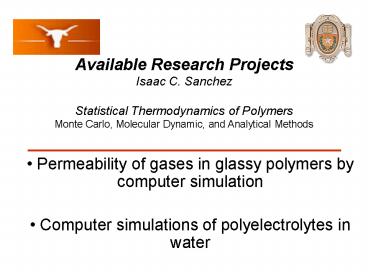Permeability of gases in glassy polymers by computer simulation - PowerPoint PPT Presentation
1 / 11
Title:
Permeability of gases in glassy polymers by computer simulation
Description:
Available Research Projects Isaac C. Sanchez Statistical Thermodynamics of Polymers Monte Carlo, Molecular Dynamic, and Analytical Methods Permeability of gases in ... – PowerPoint PPT presentation
Number of Views:111
Avg rating:3.0/5.0
Title: Permeability of gases in glassy polymers by computer simulation
1
Available Research ProjectsIsaac C.
SanchezStatistical Thermodynamics of
PolymersMonte Carlo, Molecular Dynamic, and
Analytical Methods
- Permeability of gases in glassy polymers by
computer simulation - Computer simulations of polyelectrolytes in
water
2
Folding a Polymer Chain into a Simulation Box
3
Diffusion Calculation
4
Solubility measurement
5
(No Transcript)
6
Comparison of Permeability of PTMSP and TFE/BDD
at T35C
7
Cavity Size Distributions
Xiao-Yan Wang et al. Cavity size distributions in
high free volume glassy polymers by molecular
simulation, POLYMER, 45(11), 3907-3912, 2004.
8
Transport Properties of CO2 in PTMSP and TFE/BDD
9
Polyelectrolyte Conformational Behaviors
10
Biological Implications
- It is remarkable that heating to raise the
temperature of aqueous solutions can give rise to
organized proteins this transition provides a
fundamental mechanism whereby proteins fold and
function and whereby the energy conversions that
sustain living organisms can occur at constant
temperature. - Urry, D. W. "Physical Chemistry of Biological
Free Energy Transduction as Demonstrated by
Elastic Protein-Based Polymers," Journal of
Physical Chemistry B 1997, 101, (51),
11007-11028.
11
Some Recent PhD Titles
- Statistical Thermodynamics of Stimuli Responsive
Polymers (2009) - Effects of Supercritical Fluids on Thin Polymer
Films (2007) - Empty Space and How Things Move Around in It
- (2006)
- Monte Carlo Studies of Polymer Chain Solubility
in Water (2005) - Exploring Solvent Properties of High Pressure
CO2 via Computer Simulation (2003) - Monte Carlo Approaches to the Protein Folding
Problem (2002)



























![Report on Global Superabsorbent Polymers - Size, Share, Growth [2014 – 2021] PowerPoint PPT Presentation](https://s3.amazonaws.com/images.powershow.com/8310821.th0.jpg?_=201512070411)



